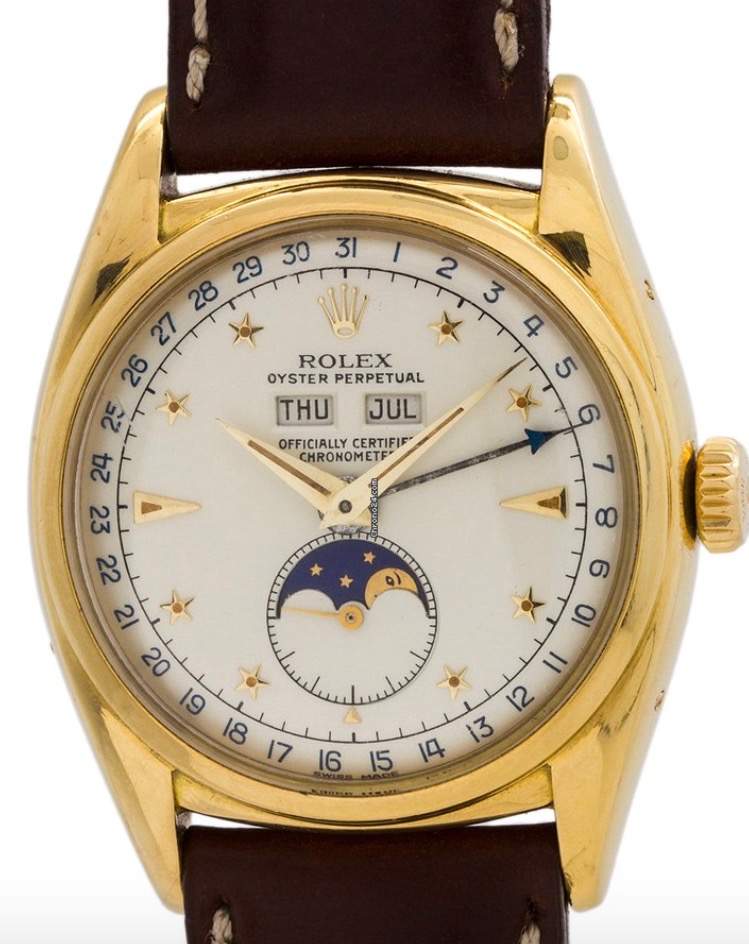The 6062 is one of the all-time great Rolex watches.
We have written about it numerous times, including about its unique two tone dial, about the rare black dial series 6062 and of course about the most famous of them all – the Bao Dai Rolex 6062. What we have not really covered yet is how to spot a correct original dial from a service or replacement dial.
The 6062 is for many collectors – the end game in Rolex collecting.
It is the most complicated time only Rolex with a triple calendar moon – phase made only for a brief period of time in the 1950s. But quite a few of these special watches do not have the correct original dial anymore. They carry instead ‘service dials’ that Rolex put on when the watch was sent in for service. Now it should be stated that a correct service or replacement dial is in itself not a bad thing. Service dials 6062 are still valuable watches and the dials are original parts that come from Rolex. A 6062 with replacement dial can easily fetch over CHF 100’000 like this one did in 2008 – selling for USD 119’000. A 6062 with service dial from Antiquorum in May in Geneva this year just sold for CHF 125’000 (see picture here). So service dials are worth some serious money too.
However, a service dial will never carry the value of an original dial. This is why it is important to tell the two apart. Also, it is important for collectors to distinguish correct service and replacement dials (as in main picture watch) from complete fake dials that sometimes appear on these watches too.
Normally service dials are quite easy to spot with Rolex. For example, within the Submariner world, everything that is from 1962 or before should carry Swiss only signed dials. Anything other than that – like t>25 signed dials are likely replacement dials if the case number is attributed to 1962 or earlier.
But with the 6062 collectors have to be more careful. Not all original 6062 dials are the same.
For example, the signature on a gold cased 6062 (signed only ‘Swiss’) are signed differently than the steel watches (signed ‘Swiss Made’). However, it gets even more complicated than that. The general rule of all 6062 gold cases being signed Swiss only, and steel signed ‘Swiss Made’ hold true – except for gold explorer dial watches. These too are signed ‘Swiss Made‘. Also, the numbers font rule- which we will explain later – of open 6 etc, does not apply to those watches with explorer dials. The font there seems to be different in all watches that have an explorer dial layout.
So to summarise: The dials of the 6062 are 1) Swiss only for normal gold watches 2) Swiss made for Explorer dial gold watches 3) All steel watches are signed Swiss made.
With that being said, let’s go into the main differences of original dials versus a service dial for the 6062.

(Credit: Antiquorum).
The watch above is an example of a correct service or replacement dial of a Rolex 6062. It ended up selling at Antiquorum in May 14th, 2017 in Geneva for CHF 125’000.
At first glance the dial is very similar to an original 6062. Same Rolex font on the Rolex signature and OCC writing below the date. But if you start looking at the details (and with Rolex – the devil is ALL in the details) there are some notable differences between an original dial and replacement. Let us go through them. These are in order of reliability as not all rules carry the same weight with the 6062 according to my research.
The first two factors are quite reliable when telling a 6062 original from replacement dials. The last one should be taken with a grain of salt as there are exceptions.
- First and most important difference: The signature at the bottom of the dial. Signed ‘T Swiss T’. Original dials are signed ‘Swiss’ only. The T stands for tritium and since the 6062 is a 1950s dial it logically cannot have that sort of signature. That should be the first obvious warning. With that being said some replacement dials also are signed only ‘Swiss’. So the collector has to be extremely careful here.
- Second difference is the moon phase. Look at the 5 seconds interval at the moon phase. The lines are thick and at the 15 seconds mark extend way beyond the moon phase line. The original dials are much finer lines and the 15 seconds mark line is not extended beyond the moon phase (see picture here). Almost all replacement dials are a dead give-away when looking at the moon-phase area and the thick seconds markers they alway carry.
- Third difference: Often when the dial is serviced – the original hands also get changed along with the new dial. In this case above – the minute and hour hand are not original (the form is different, looking more like the Dauphine hands from Patek and there is no lume on the hands which was the case with original hands). Also the outer calendar ring hand is not original. The arm of the calendar ring should be thinner and the arrow sharper and more pointed, as in this picture here.
- Fourth difference: The calendar ring numbers font: The numbers are almost always much thicker in font with replacement dials than in the original dials which are often more pale in appearance (I am mostly referring to white dial 6062 here). They are also a more intense blue appearance. However, I have seen exceptions like here.
To briefly comment on the factors above.
The first factor is very reliable however there are a few ‘Swiss’ only signed dials that are also in my view replacement dials but they are quite recognisable (more on that later). The second factor is for me the most reliable factor to differentiate service versus original dials. The third factor is also quite reliable as most service dials lose the original hands and outer calendar ring hand (again not fault proof as I have seen many replacement dials with the correct hands).
The fourth difference is trickiest and is the least reliable in my opinion.
To expand on the last point, the outer calendar numbers ring is an area which many collectors focus on when analysing 6062 models. However collectors have to be very careful making judgements based on the outer calendar ring font or number style. What we can say is the following after having studied the outer calendar ring of numerous original dials (both black and white).
- Black dials generally have a thicker font calendar ring than white dials.
- The font of style of the calendar ring (so open 6, 16 or curved 7 etc.) depends on the dial type (so star dial versus pyramid, or spade dial etc).
- For example, within black dials the font and style can differ depending on if it is a star, spade or pyramid dial (see picture here).
- Even within a certain type of dial (like pyramid dials white) there can be variation in outer calendar ring fonts and style (see picture here).
To better understand the differences between a replacement dial and original dial look at the pictures below showing an original 6062 dial versus a replacement dial.
Let us look at a close-up of an original star dial 6062.
First: Notice the open 6 in the number 16 which is more open than the service dial noted in our report earlier. Secondly: See the 15 seconds marker and 5 seconds interval markers in the moon phase area- it does not extend beyond the moon phase. Third: Notice also the correct ‘Swiss’ only signature.
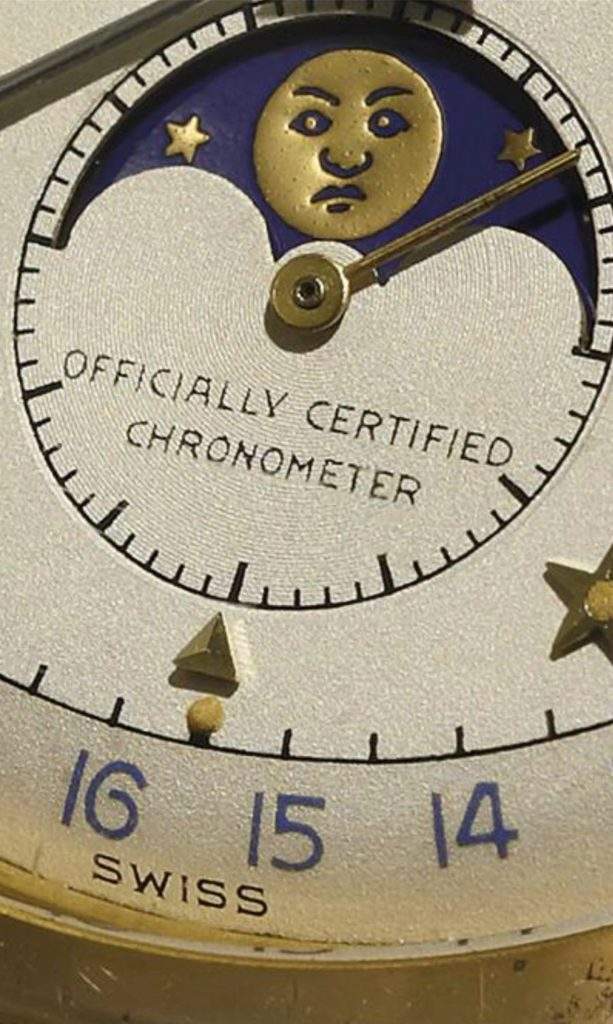
(Credit: Phillips watches).
Below the replacement dial of the watch in the main report.
Notice how the 15 seconds marker (on both sides left and right) within the moon phase extends beyond the moon phase. This for me is the easiest way to tell and replacement dial versus original one. Also the 5 second markers within the moon – phase are thicker and not fine like with the original dials. This watch ended up selling for CHF 125’000 at Antiquorum in May 2017 in Geneva.
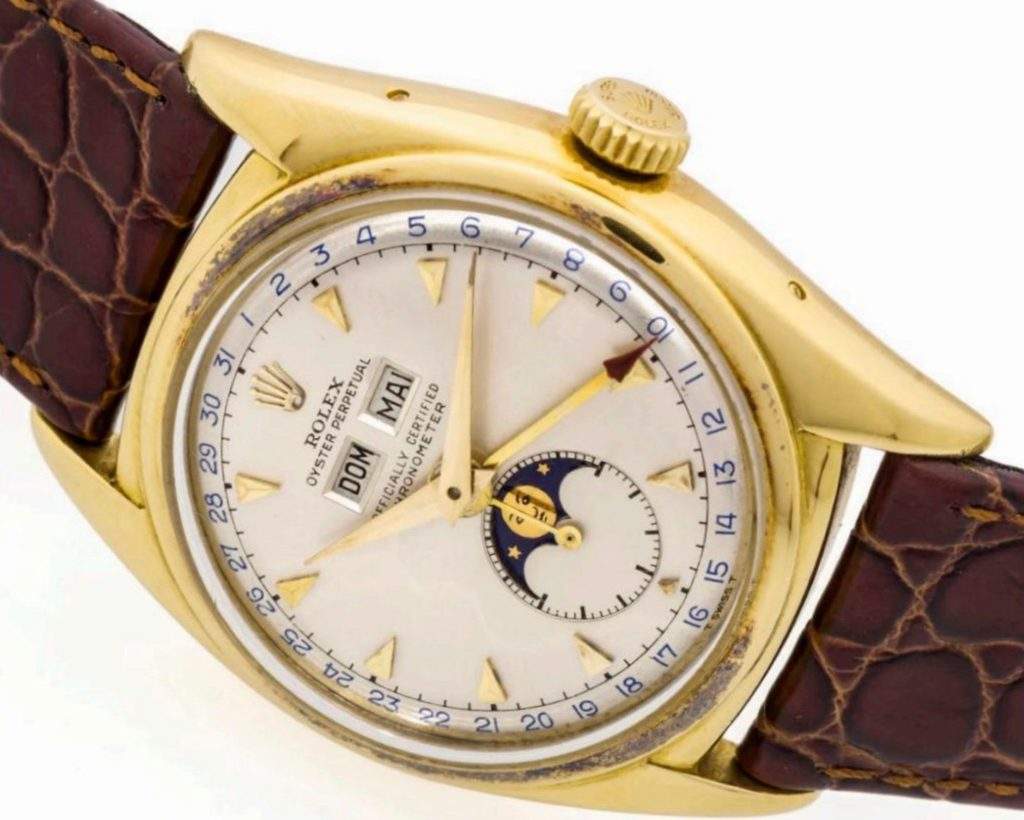
(Credit: Antiquorum).
Below an original thin outer calendar hand versus the thick replacement version above.
Notice also the original hands (hour and minute) below versus likely replacement above. Lastly – look at the numbers and the way they close. Below the open six and 16, and open 26 which is correct and not closed as above. This thin font and open numbers (like 16) is typical of gold watches and is much less seen on black dials.
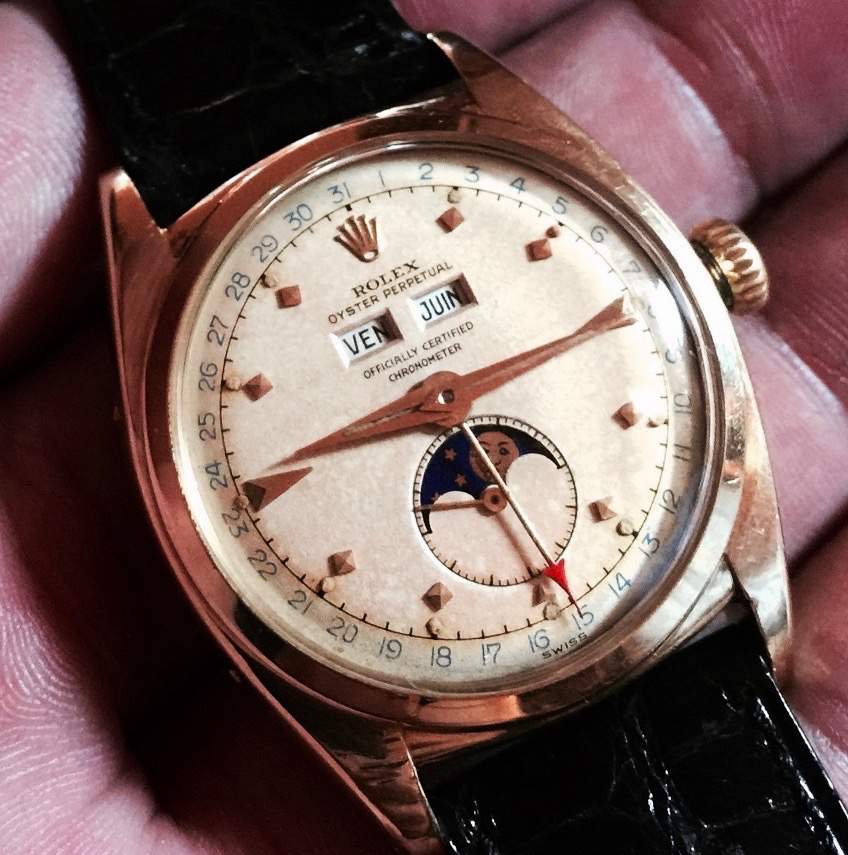
(Credit: Rolexpassion report).
Notice the font and style of Swiss made signed dials of an explorer dial gold 6062 (see picture below). Here the style is more closed again and the font seems bluer and more intense.
My best guess why these dials are more intense blue and the font and style is different because these dials (explorer dials) were made towards the end of the production period. Don’t forget that explorer dials are predominantly found in steel cased watches and they were made towards the end of the production of 6062.
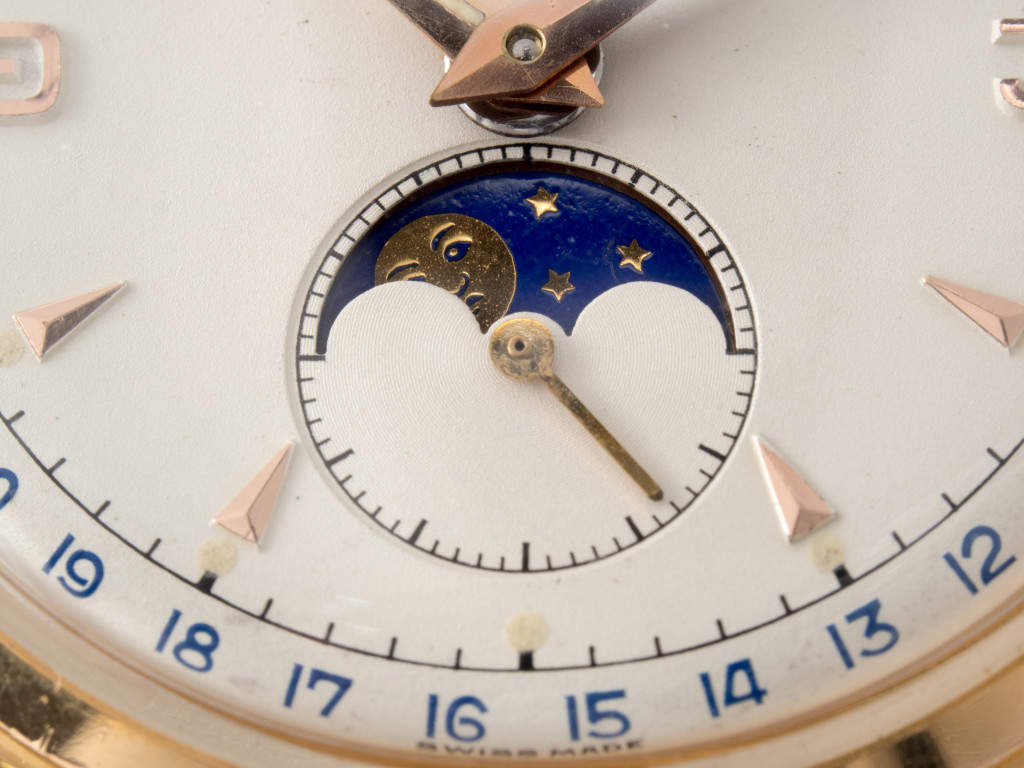
While I am on the subject – lets briefly comment on the explorer dials in steel watches.
First as you may know – all steel 6062 are by definition explorer dial watches. If you look at the steel watches more closely you will also notice that all are signed Swiss made, so similar to the 6062 gold explorer dial.

(Credit: Jason Singer).
What is further interesting to note is the following: Many steel watches also have this deep blue outer ring, with all closed numbers. This actually makes perfect sense. Let me explain.
The very final production batch of the entire 6062 production are the rare steel cased watches starting 942 59x. So, it could be by then that Rolex slightly changed the dial fonts in terms of the outer calendar ring. This is also why that they resemble the replacement dials that probably came shortly after the steel watches were finished in production.
But as I mentioned in my main part of the report- we cannot make good judgements based purely on the font and writing of the outer calendar ring. There is too much variation to come to any good conclusions.
While we are at it, let us also briefly mention the black dial 6062 – the most rare and collectable triple calendar moon phase from Rolex.
As I mentioned before, on balance, black dials tend to have a very slightly thicker font than white dials.
The thickness is only very marginal and it could also be because of the black dial and gold printing that we think the font is thicker. See picture below. Also notice the calendar ring. Although both are star dials, the font and style of the numbers are very different (look at the 17 which is straight with the black dial and curved with the white dial, and 14 which has a longer top with the black dial and shorter top with the white dial).
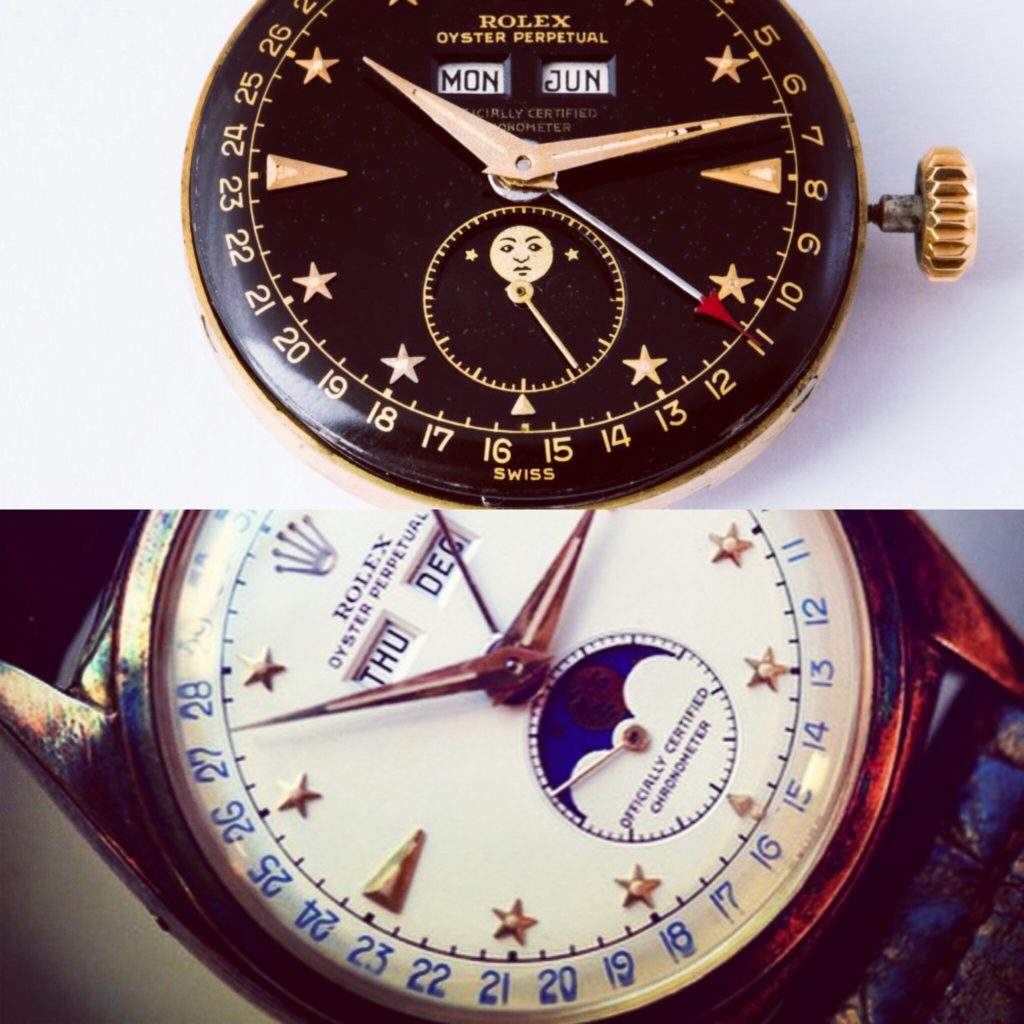
Even within the same color dials there are differences in fonts and style and not all black dials are the same.
According to our research there is some variation in thickness and style font within black dials themselves – depending on dial layout (so star, pyramid, spade). Just look at the picture below. Not only are the fonts slightly thicker or thinner but the style layout is also different (open 16 versus closed 16 and curved 17 versus normal 17).
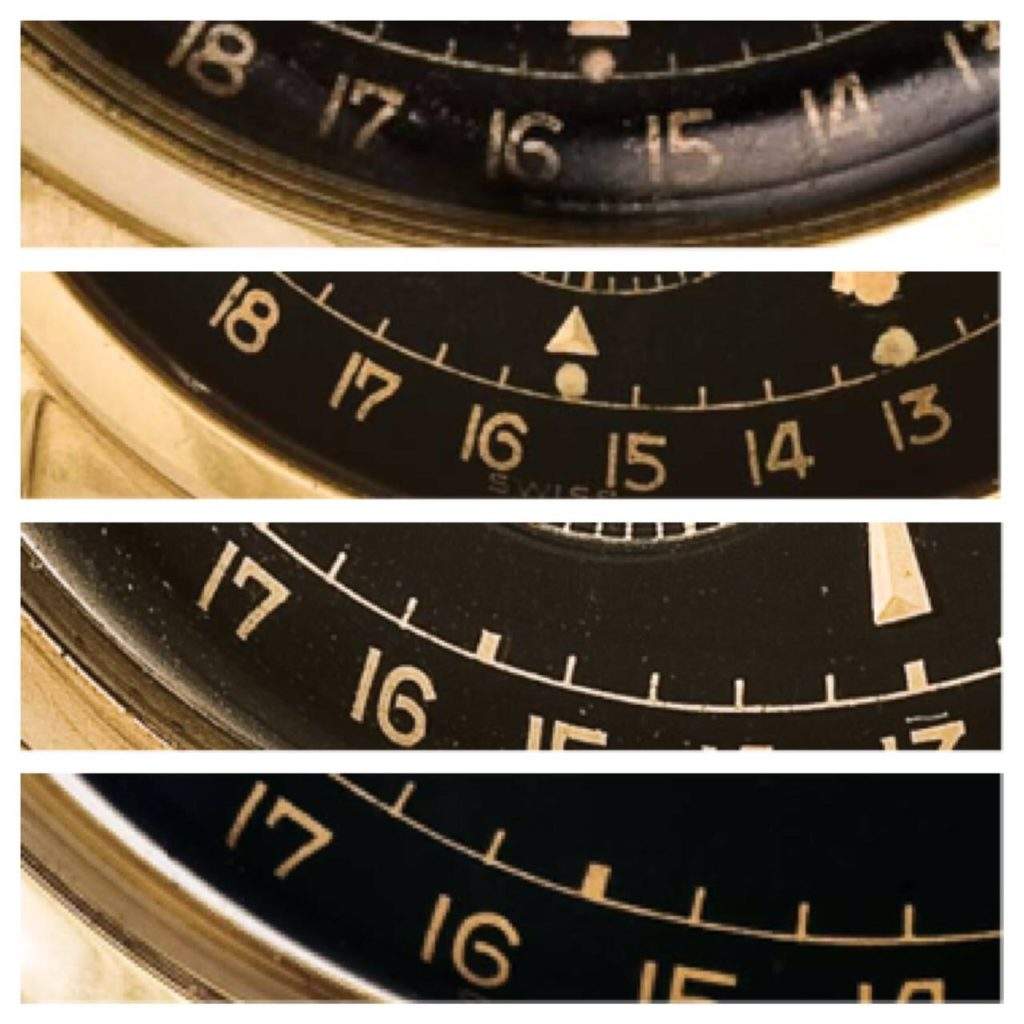
(Picture credit: Rare & fine).
Let us get back to gold 6062 cases and their dials.
Remember what I said about black dials and how the font differs for them depending on the type of dial? Well the same applies to gold dials. But it gets even more tricky. Even if the dial type is similar (so taking two pyramid dials for comparison) there can be different type of calendar rings in terms of font and style of numbers. Just look below.
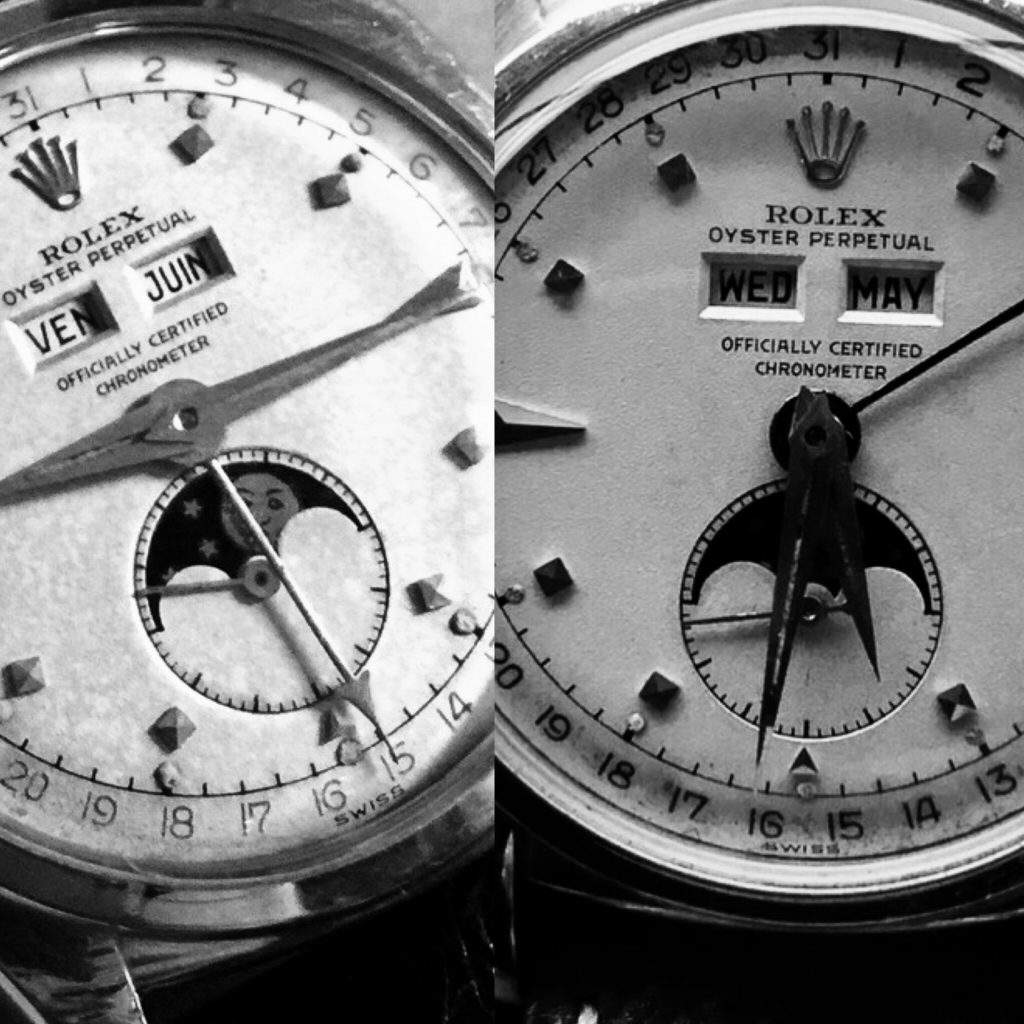
We have taken two original pyramid dials with similar reference numbers (911 xxx and 942 xxx). Even though both were made at a similar time frame (remember Rolex started making 6062 as early as 620 xxx) and both are pyramid dials – the numbers font and style are very different!
The first pyramid dial on the right above has thinner font and open 15 and curved 17. The pyramid dial on the right has a bolder calendar font (seen in later 6062 examples like in the steel 6062 and gold explorer dials as well as black dials) and non curved 17 and closed 16.
So, we have to be very careful making judgements based on outer calendar ring numbers alone. Both are original dials with the Swiss only signature.
For comparison purposes here another service or replacement dial that was sold by Dr. Crott a few years ago. Notice the T Swiss T signature at the bottom – clear evidence that this is a service dial.
Interestingly enough – here the hands and calendar arm hand appear correct. The dial appears to be more silver in nature than white and graine often found on original dials. Again, the moon phase is a clear give away that the dial is a service dial. Long seconds markers within the moon phase and different thickness of the 15 seconds markers too.

(Credit: Dr. Crotts Auctioneers).
If you think all replacement or service dials are have triangular hour markers – you would be mistaken.
I have found what is highly likely a service or replacement dial – but with star hour markers. How can I be pretty sure? Well we cannot see how the dial is signed (Swiss made or Swiss) and honestly speaking I have no clue how this dial is signed even today. But here is something else we can look at: The seconds markers on the moon phase seem overextended.
At the end though – it was the price of CHF 74’500 that seemed to be the main give away. This star dial sold for CHF 74’500 back in 2010. I promise you – if this was an original dial – we would be talking CHF 2-300’000 even back in 2010 (for the full listing of this watch please see here).
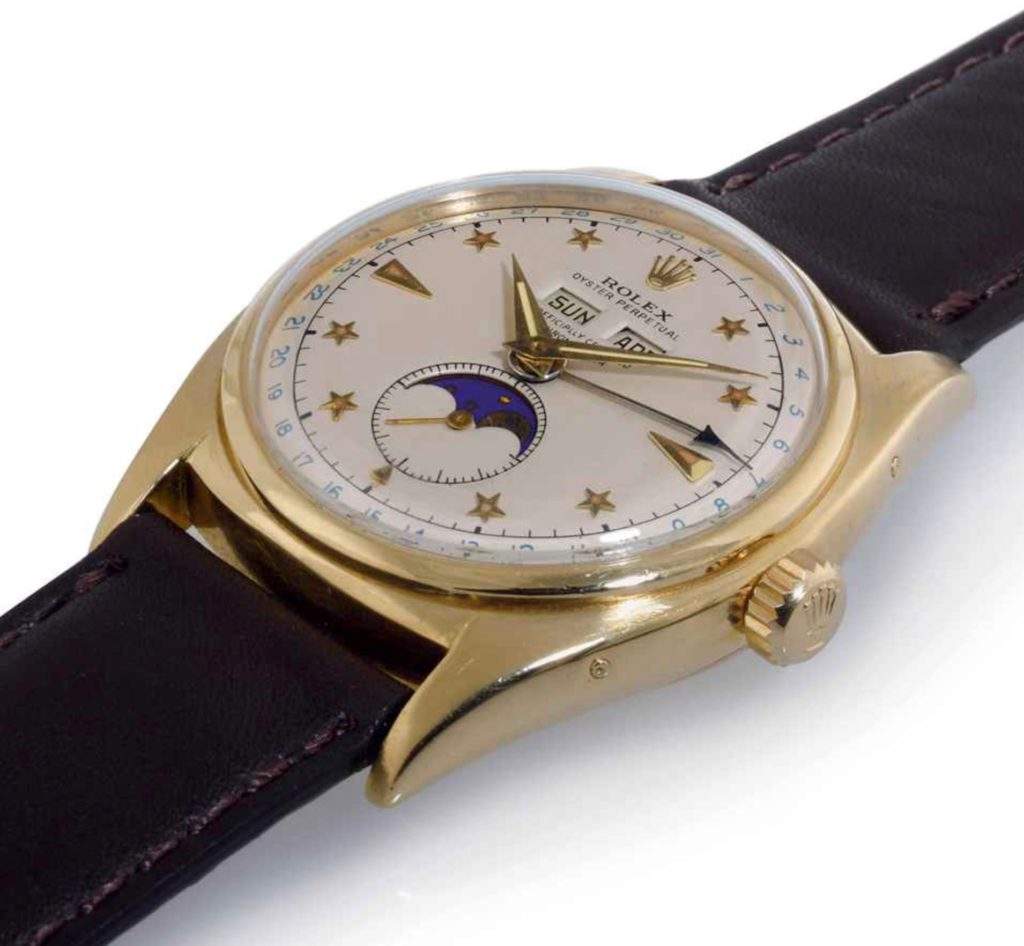
(Credit: Christies watches).
So are all replacement dials signed T Swiss T? No, it is not that easy.
Most of the replacement dials are signed T Swiss T and also have the triangular markers as the main picture of this report. However I have seen a few other dials that are only ‘Swiss’ signed but in all likelihood (we can never be sure in the Rolex world) are also replacement dials.
Have a look at this watch below. It is stelline or star dial. At first glance it looks fine right?
But have a look at the details. Look at the ‘Swiss’ sign on the bottom. The spacing of Swiss and how it is positioned at the edge of the dial. Also look at the moon – phase second markers. Thick and long like those on the replacement dials usually found on T Swiss T. Visually speaking the dial is just not like on pristine star dials found here and here – the famous world record NOS one. This was is only a few serial numbers away from the two watches below and I cannot imagine Rolex having two different style of fonts and moon phases for star dials. That is not how Rolex operates.
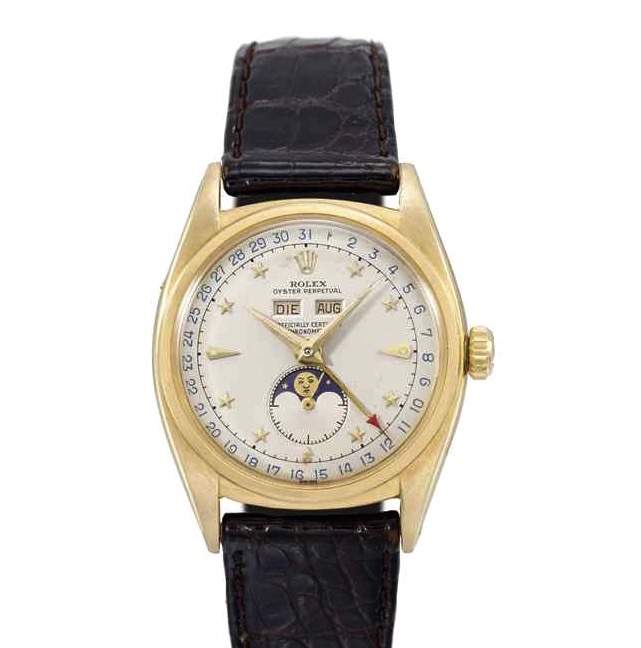
Below a star dial how it should look in my view. No long moon-phase seconds markers, and a ‘Swiss’ that is not placed near the edge of the dial.
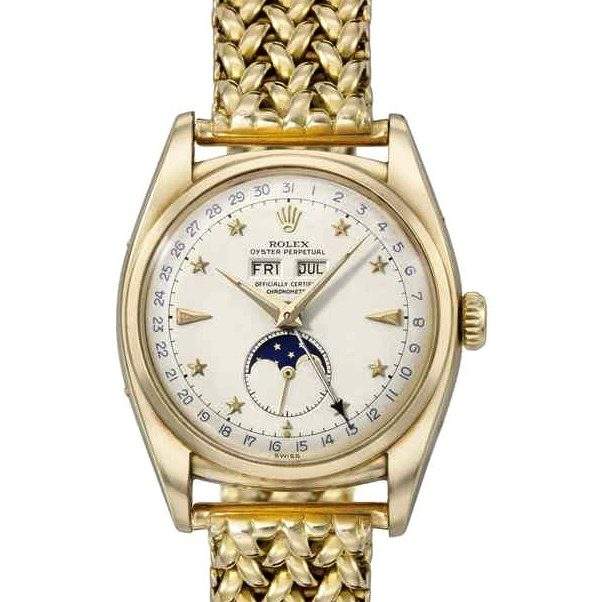
It is easy to write this report in hindsight of having the market back me up. Without specifying where the watches came from, the watch above sold for more than 2x the watch that has the star dial with the rather strange Swiss spacing and peculiar moon phase seconds markers.
When studying the reference of something it helps to look at an untouched and NOS version that came to the market a few years ago at Christies in 2011 – the legendary ‘sock version’.
It was essentially a NOS version, completely untouched und unworn. The owner put it in a sock and forgot about it. It sold in 2011 for an astonishing CHF 542’000. The original listing can be seen here.
Here the evidence is very clear again. Correct outer calendar ring font and style, correct calendar ring hand. Correct moon-phase seconds markers. I always go back and study this example when I am unsure of any 6062. This watch is a perfect example how an untouched 6062 star dial should look like.

(Credit: Christies / Hodinkee).
Just for comparison purposes we show you the other end of the spectrum – a very questionable (to put it mildly) 6062 with a ‘Swiss’ only signed dial.
Almost everything is not what you would expect of an original first series dial 6062. The Rolex writing and oyster perpetual appears too close to the crown. Non-correct moon phase second markers. Non-correct minute and hour hands and wrong hand for outer calendar ring.
What is peculiar with this watch is the minute markings on the dial. The dots for the minute markers are called ‘open track dials’ and although I have seen one at auction before – these type of dials are very questionable amongst scholars.
Lastly also observe the wrong type bracelet fitted to this watch (oyster bracelet instead of the correct jubilee).
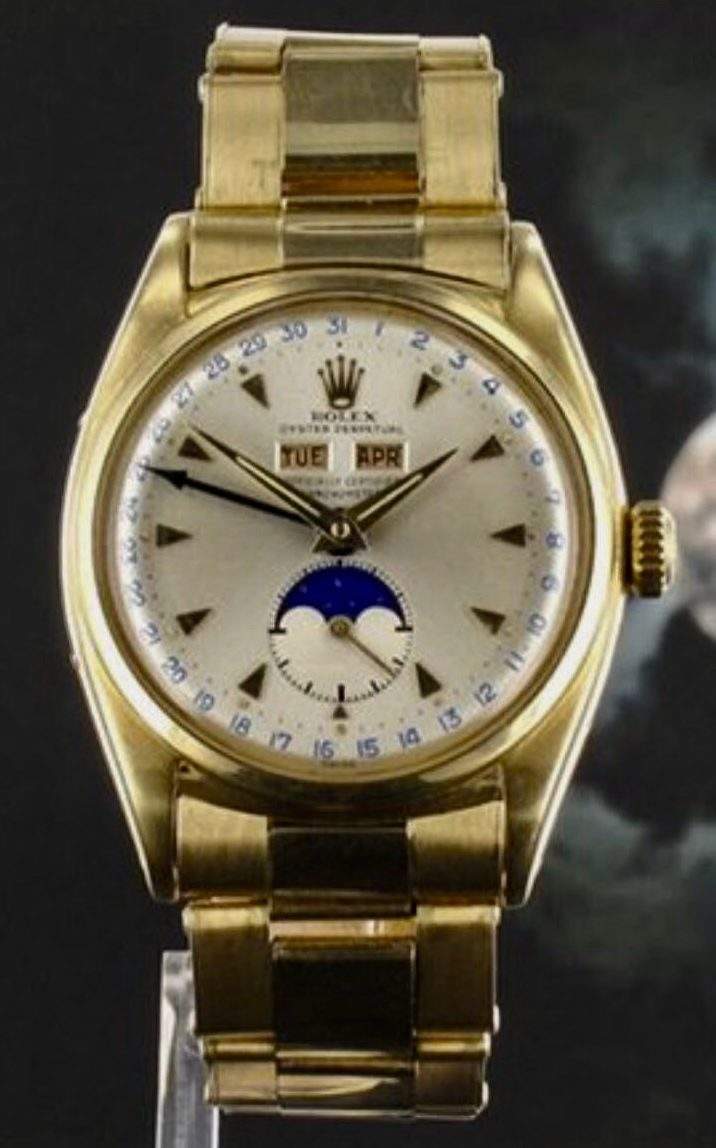
(Credit: Chrono24).
Concluding thoughts
For me there are two reliable measures to test an original dial versus a replacement dial when it comes to 6062.
First is the signature at the bottom. Second is to study the moon – phase second markers. However other measures should be also used such as 1) the font of the calendar ring 2) the calendar outer ring hand and original hour and minute hands – on good dials they are often still present – on replacement dials they are often also replaced along with the dial.
Most of the time replacement dials are carefully noted by auction houses and there is no real problem with them. As I mentioned in the beginning – a replacement dial is an original Rolex part and there is nothing wrong with replacement dials. Often owners sent their watches in to Rolex for service and repair and that is part of their history of the dial was changed. And as you saw with the Antiquorum watch this May, a correct replacement dial can fetch CHF 125’000 – not a bad result.
Is this report the definite guide to 6062 replacement dials? Of course not.
I am merely displaying my thoughts out loud – I have zero evidence to be 100% sure of any of my conclusions. But with a bit of common sense and having the market prices tell me in the past what it valued and what it did not – this helped me write this report (along with Rare & Fine Wulf Schütz who really knows his 6062). It also helps that I own a 6062 and have studied enough others at auction.
This post should help the collector distinguish both original and replacement dials as it relates to normal gold models 6062. After all the original dials carry a large premium to later replacement dials and the collector who can’t distinguish the two will make a costly mistake if not careful.
(NB: I would like to thank Wulf Schütz of Rare & Fine watches who provided valuable insight with his experience of handling many 6062. Below I show you two more dials that in my view are not originally born with the watch. In my opinion in the best of cases these are service dials and in the worst case not even correct service dials).
We start off with another open track minute dial.
What concerns me about this dial is the following: Usually the word precision is reserved for the sister reference of the 6062 – the 8171 Padelone. Also the thick moon phase seconds markers are another give away that this is at best case a service dial.

Another very odd dial must be this ‘Swiss Made’ signed star dial. Normally the ‘Swiss Made’ is only seen on explorer gold dials or on steel 6062 which by default are all explorer dials. A star dial with ‘Swiss Made’ is suspect in my opinion. At best this is a replacement dial – as I have never seen a star dial watch with a Swiss Made sign.
